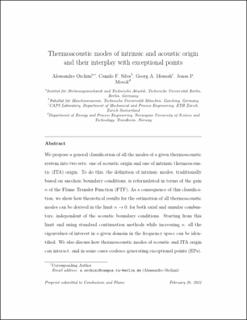| dc.contributor.author | Orchini, Alessandro | |
| dc.contributor.author | Silva, Camilo | |
| dc.contributor.author | Mensah, Georg | |
| dc.contributor.author | Moeck, Jonas | |
| dc.date.accessioned | 2021-03-24T08:47:21Z | |
| dc.date.available | 2021-03-24T08:47:21Z | |
| dc.date.created | 2019-10-15T12:48:43Z | |
| dc.date.issued | 2020 | |
| dc.identifier.citation | Combustion and Flame. 2020, 211 83-95. | en_US |
| dc.identifier.issn | 0010-2180 | |
| dc.identifier.uri | https://hdl.handle.net/11250/2735209 | |
| dc.description.abstract | We propose a general classification of all the modes of a given thermoacoustic system into two sets: one of acoustic origin and one of intrinsic thermoacoustic (ITA) origin. To do this, the definition of intrinsic modes, traditionally based on anechoic boundary conditions, is reformulated in terms of the gain n of the Flame Transfer Function (FTF). As a consequence of this classification, we show how theoretical results for the estimation of all thermoacoustic modes can be derived in the limit n → 0, for both axial and annular combustors, independent of the acoustic boundary conditions. Starting from this limit and using standard continuation methods while increasing n, all the eigenvalues of interest in a given domain in the frequency space can be identified. We also discuss how thermoacoustic modes of acoustic and ITA origin can interact, and in some cases coalesce generating exceptional points (EPs). Although all EPs found have negative growth rates, in their vicinity thermoacoustic eigenmodes have very large sensitivities and exhibit strong mode veering. We demonstrate how, in some cases, mode veering is responsible for the occurrence of thermoacoustic instabilities, and propose a numerical method to identify EPs. All the theoretical results are numerically verified using two generic thermoacoustic configurations. | en_US |
| dc.language.iso | eng | en_US |
| dc.publisher | Elsevier | en_US |
| dc.rights | Attribution-NonCommercial-NoDerivatives 4.0 Internasjonal | * |
| dc.rights.uri | http://creativecommons.org/licenses/by-nc-nd/4.0/deed.no | * |
| dc.title | Thermoacoustic modes of intrinsic and acoustic origin and their interplay with exceptional points | en_US |
| dc.type | Peer reviewed | en_US |
| dc.type | Journal article | en_US |
| dc.description.version | acceptedVersion | en_US |
| dc.source.pagenumber | 83-95 | en_US |
| dc.source.volume | 211 | en_US |
| dc.source.journal | Combustion and Flame | en_US |
| dc.identifier.doi | 10.1016/j.combustflame.2019.09.018 | |
| dc.identifier.cristin | 1737188 | |
| dc.description.localcode | © 2020. This is the authors’ accepted and refereed manuscript to the article. Locked until 3.10.2021 due to copyright restrictions. This manuscript version is made available under the CC-BY-NC-ND 4.0 license http://creativecommons.org/licenses/by-nc-nd/4.0/ " | en_US |
| cristin.ispublished | true | |
| cristin.fulltext | postprint | |
| cristin.qualitycode | 2 | |

